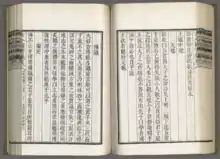Gujin Tushu Jicheng
The Gujin Tushu Jicheng (traditional Chinese: 古今圖書集成; simplified Chinese: 古今图书集成; pinyin: Gǔjīn Túshū Jíchéng; Wade–Giles: Ku-chin t'u-shu chi-ch'eng; lit. 'Complete Collection of Illustrations and Writings from the Earliest to Current Times'), also known as the Imperial Encyclopaedia, is a vast encyclopedic work written in China during the reigns of the Qing dynasty emperors Kangxi and Yongzheng. It was begun in 1700 and completed in 1725. The work was headed initially by scholar Chen Menglei (陳夢雷), and later by Jiang Tingxi.

The encyclopaedia contained 10,000 volumes. Sixty-four imprints were made of the first edition, known as the Wu-ying Hall edition. The encyclopaedia consisted of 6 series, 32 divisions, and 6,117 sections.[1] It contained 800,000 pages and over 100 million Chinese characters. Topics covered included natural phenomena, geography, history, literature and government. The work was printed in 1726 using copper movable type printing. It spanned around 10 thousand rolls (卷). To illustrate the huge size of the Gujin Tushu Jicheng, it is estimated to have contained 3 to 4 times the amount of material in the Encyclopædia Britannica Eleventh Edition.[2]
In 1908, the Guangxu Emperor of China presented a set of the encyclopaedia in 5,000 fascicles to the China Society of London, which has deposited it on loan to Cambridge University Library.[3] Another one of the three extant copies of the encyclopedia outside of China is located at the C.V. Starr East Asian Library at Columbia University. A complete copy in Japan was destroyed in the 1923 Great Kantō earthquake.
One of Yongzheng's brothers patronised the project for a while, although Yongzheng contrived to give exclusive credit to his father Kangxi instead.
Compilation
The Kangxi Emperor hired Chen Menglei of Fujian to compile the encyclopedia. From 1700-1705, Chen Menglei worked day and night, writing most of the book, including 10,000 volumes and around 160 million words. It was originally titled the Compendium or Tushu Huibian (图书汇编). By 1706 the book's first draft was completed, and the Kangxi emperor changed the title to Gujin Tushu Jicheng. When the Yongzheng emperor ascended the throne, he ordered Jiang Tingxi to help Chen Menglei finish the encyclopedia for publication by around 1725.[4]
Outline
The 6 series are as follows.[5]
- Heavens/Time/Calendrics (历象): Celestial objects, the seasons, calendar mathematics and astronomy, heavenly portents
- Earth/Geography (方舆): Mineralogy, political geography, list of rivers and mountains, other nations (Korea, Japan, India, Kingdom of Khotan, Ryukyu Kingdom)
- Man/Society (明论): Imperial attributes and annals, the imperial household, biographies of mandarins, kinship and relations, social intercourse, dictionary of surnames, human relations, biographies of women
- Nature (博物): Procivilities (crafts, divination, games, medicine), spirits and unearthly beings, fauna, flora (all life forms on Earth)
- Philosophy (理学): Classics of non-fiction, aspects of philosophy (numerology, filial piety, shame, etc.), forms of writing, philology and literary studies
- Economy (经济): education and imperial examination, maintenance of the civil service, food and commerce, etiquette and ceremony, music, the military system, the judicial system, styles of craft and architecture
The six series in total are subdivided into 32 subdivisions.
Note that a pre-modern sense is intended in both "society" (that is, high society) and "economy" (which could be called "society" today), and the other major divisions do not match precisely to English terms.
See also
References
Citations
- "Ku-chin t'u-shu chi-ch'eng (Completed Collections of Graphs and Writings of Ancient and Modern Times)". npm.gov.tw. Archived from the original on 2010-11-25. Retrieved 2012-07-25.
- Fowler, Robert L. (1997), "Encyclopaedias: Definitions and Theoretical Problems", in P. Binkley, Pre-Modern Encyclopaedic Texts, Brill, p. 9; citing Diény, Jean-Pierre (1991), "Les encyclopédies chinoises," in Actes du colloque de Caen 12-16 janvier 1987, Paris, p. 198.
- "Introduction to the Chinese Collections". Cambridge University Library. Archived from the original on 2012-12-23. Retrieved 2012-07-25.
- Elman, Benjamin A. (2009-06-30). On Their Own Terms: Science in China, 1550-1900. Harvard University Press. ISBN 978-0-674-03647-5.
- "An alphabetical index to the Chinese encyclopaedia ... Chʻin ting ku chin tʻu shu chi chʻêng". 1911.
Sources
- Search for Modern China, Jonathan Spence, 1990.
External links
| Chinese Wikisource has original text related to this article: |
- 故宮東吳數位古今圖書集成 etext
- WorldCat
- Archive.org
- HathiTrust
- An Alphabetical Index To The Chinese Encyclopaedia
- WorldCat
- Google Books
- Archived 2010-11-25 at the Wayback Machine
- Library of Congress